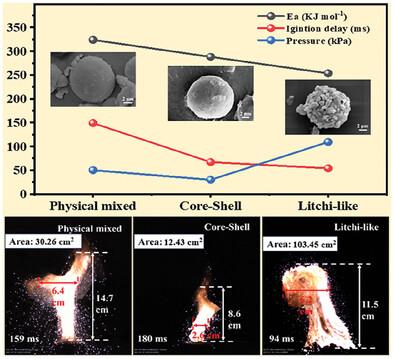Design of Litchi-Like Al/PTFE with Superior Reactivity and Application in Solid Propellants
IF 13
2区 材料科学
Q1 CHEMISTRY, MULTIDISCIPLINARY
引用次数: 0
Abstract
The combustion efficiency and reactivity of aluminum (Al) particles, as a crucial component in solid propellants, are constrained by the inert oxide layer aluminum oxide (Al2O3). Polytetrafluoroethylene (PTFE) can remove the oxide layer, however, carbon deposition generated during the reaction process still limits the reaction efficiency of Al/PTFE fuel. Here, a litchi-like Al/PTFE fuel with the nano-PTFE islands distributed on the Al particles surface is successfully designed, based on localized activation and synergistic reaction strategies, to solve the Al2O3 layer and carbon deposition. This unique PTFE-coated structure can achieve localized activation of Al by surface etching, creating reaction channels, and exposing the active Al. Such a channel network promotes the circulation of fluorine and oxygen, stimulating the synergistic reactions of Al-F and Al-O and energy output. Regulating the PTFE content can maximize the elimination of carbon deposition and achieve the full combustion reaction of Al/PTFE. The maximum flame area and pressure output of the litchi-like Al/PTFE fuel increased by 241.9%, 734.7%, 118.4%, and 265.2%, respectively, compared with traditional physical mixture and core-shell structure Al/PTFE fuels. The localized activation and synergistic effects of litchi-like structure effectively transform carbon waste into a valuable resource, introducing a novel approach for the propellants.

求助全文
约1分钟内获得全文
求助全文
来源期刊

Small
工程技术-材料科学:综合
CiteScore
17.70
自引率
3.80%
发文量
1830
审稿时长
2.1 months
期刊介绍:
Small serves as an exceptional platform for both experimental and theoretical studies in fundamental and applied interdisciplinary research at the nano- and microscale. The journal offers a compelling mix of peer-reviewed Research Articles, Reviews, Perspectives, and Comments.
With a remarkable 2022 Journal Impact Factor of 13.3 (Journal Citation Reports from Clarivate Analytics, 2023), Small remains among the top multidisciplinary journals, covering a wide range of topics at the interface of materials science, chemistry, physics, engineering, medicine, and biology.
Small's readership includes biochemists, biologists, biomedical scientists, chemists, engineers, information technologists, materials scientists, physicists, and theoreticians alike.
 求助内容:
求助内容: 应助结果提醒方式:
应助结果提醒方式:


